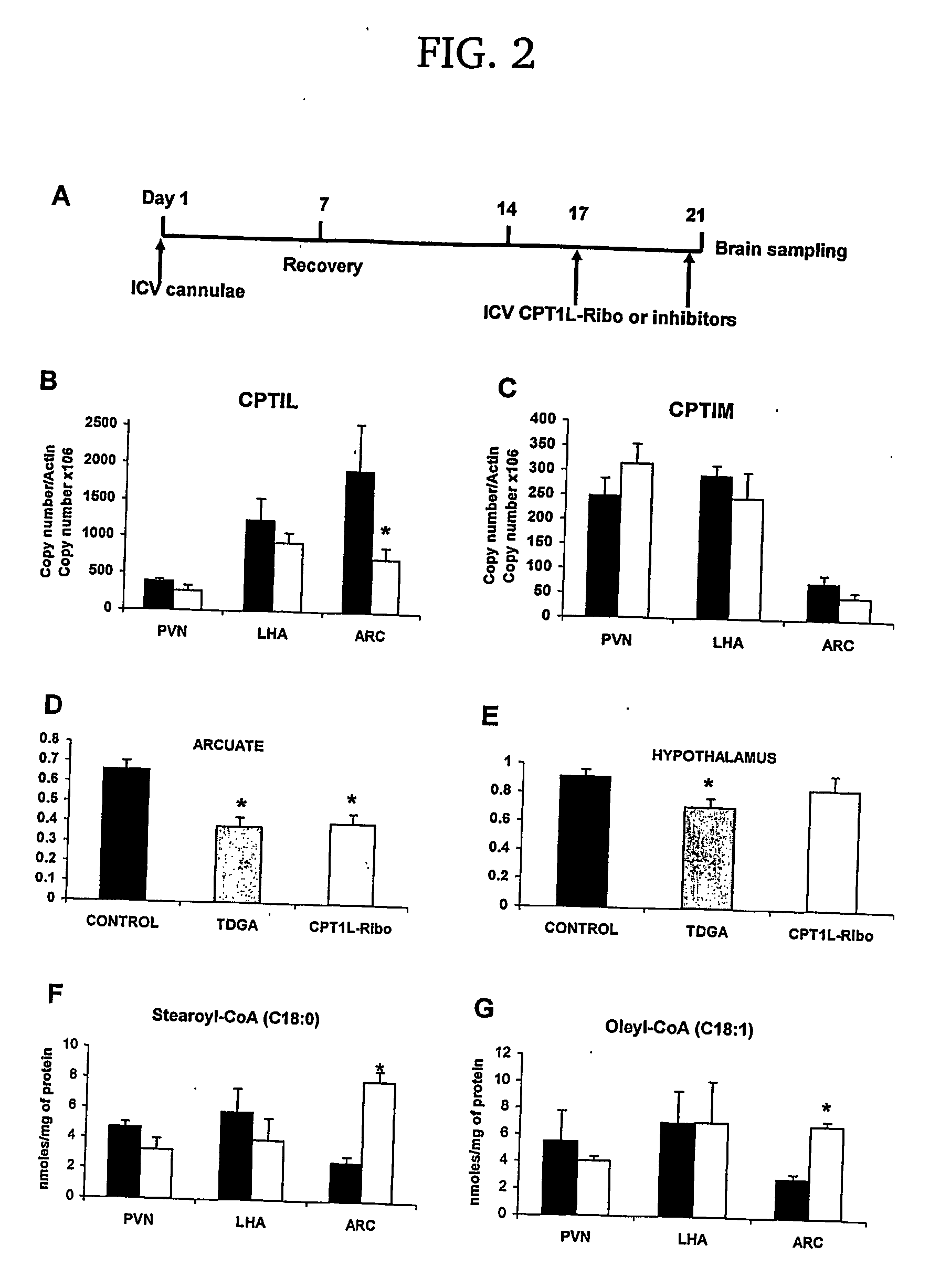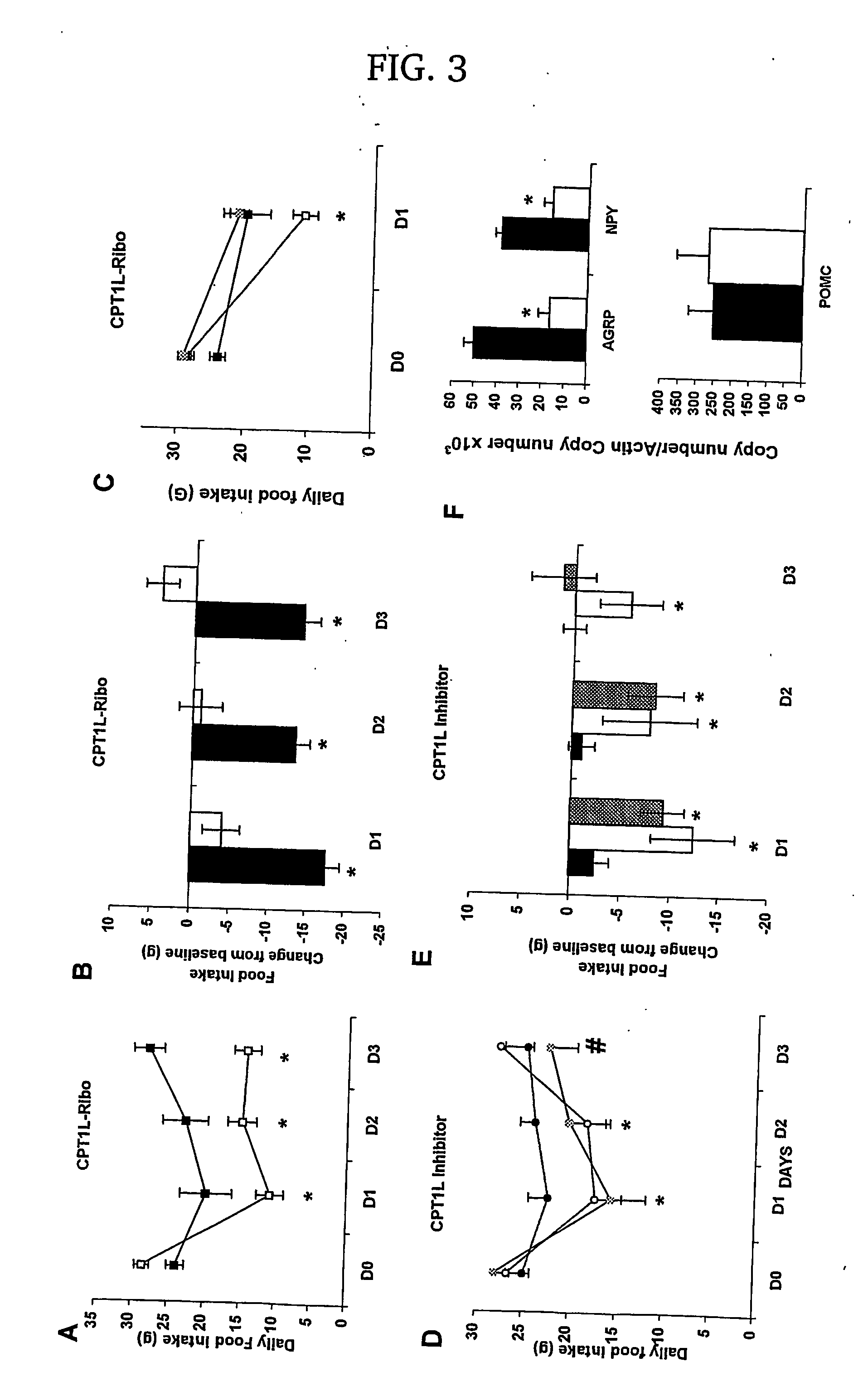Regulation of food intake and glucose production by modulation of long-chain fatty acyl-coa levels in the hypothalamus
a technology of lc-coa and hypothalamus, which is applied in the direction of peptide/protein ingredients, dna/rna fragmentation, viruses, etc., can solve the problem of ineffective negative feedback in overfed animals, achieve increased lc-coa levels, reduce food intake and glucose production, and increase lc-coa levels
- Summary
- Abstract
- Description
- Claims
- Application Information
AI Technical Summary
Benefits of technology
Problems solved by technology
Method used
Image
Examples
example 1
Inhibition of Hypothalamic Carnitine Palmitoyltransferase-1 Decreases Food Intake and Glucose Production
example summary
[0156] The enzyme carnitine palmitoyl transferase-1 regulates the entry of long-chain fatty acids in the mitochondria where they can undergo β-oxidation. In order to examine novel mechanism(s) by which central metabolism of lipids can modulate energy balance, we aimed to selectively reduce lipid oxidation in the hypothalamus. To this end, the activity of carnitine palmitoyl transferase-1 was diminished via administration of a ribozyme-containing plasmid designed to specifically decrease the expression of this enzyme or via infusion of pharmacological inhibitors of its activity in the third cerebral ventricle. Either genetic or biochemical inhibition of hypothalamic carnitine palmitoyl transferase-1 activity was sufficient to markedly diminish food intake and endogenous glucose production. These results indicate that changes in the rate of lipid oxidation in selective hypothalamic neurons can signal nutrient availability to the hypothalamus, which in turn modulates the exogenous and ...
example 2
Modulation of Long-Chain Co-A levels (LC-CoAs) in the hypothalamus regulates food intake and glucose production
[0180] This example describes experiments using methods described in Example 1.
[0181] Diet-induced obesity results in a marked decrease in hypothalamic LC-CoAs. In order to test whether a decrease in hypothalamic ‘lipid signal’ could play a role in diet-induced obesity, we measured the levels of LC-CoAs in the Arcuate nuclei (ARC) of rats fed a highly palatable diet for three days (Obici et al., 2002a). The latter is an excellent model for human obesity and diet-induced insulin resistance since it is not based on a single gene defect. Despite receiving a diet very rich in saturated fatty acids, the levels of ARC LC-CoAs were decreased by ˜60% in over-fed rats compared with either rats on a regular chow or with rats on the high fat regimen pair-fad with the regular chow rats. These surprising results support the presence of a deficient negative feed-back between circulatin...
PUM
| Property | Measurement | Unit |
|---|---|---|
| time | aaaaa | aaaaa |
| voltage | aaaaa | aaaaa |
| leptin resistance | aaaaa | aaaaa |
Abstract
Description
Claims
Application Information
 Login to View More
Login to View More - R&D
- Intellectual Property
- Life Sciences
- Materials
- Tech Scout
- Unparalleled Data Quality
- Higher Quality Content
- 60% Fewer Hallucinations
Browse by: Latest US Patents, China's latest patents, Technical Efficacy Thesaurus, Application Domain, Technology Topic, Popular Technical Reports.
© 2025 PatSnap. All rights reserved.Legal|Privacy policy|Modern Slavery Act Transparency Statement|Sitemap|About US| Contact US: help@patsnap.com



